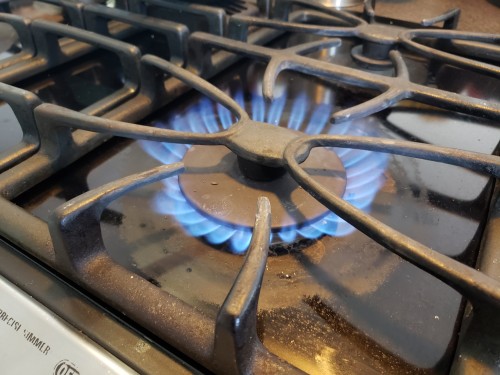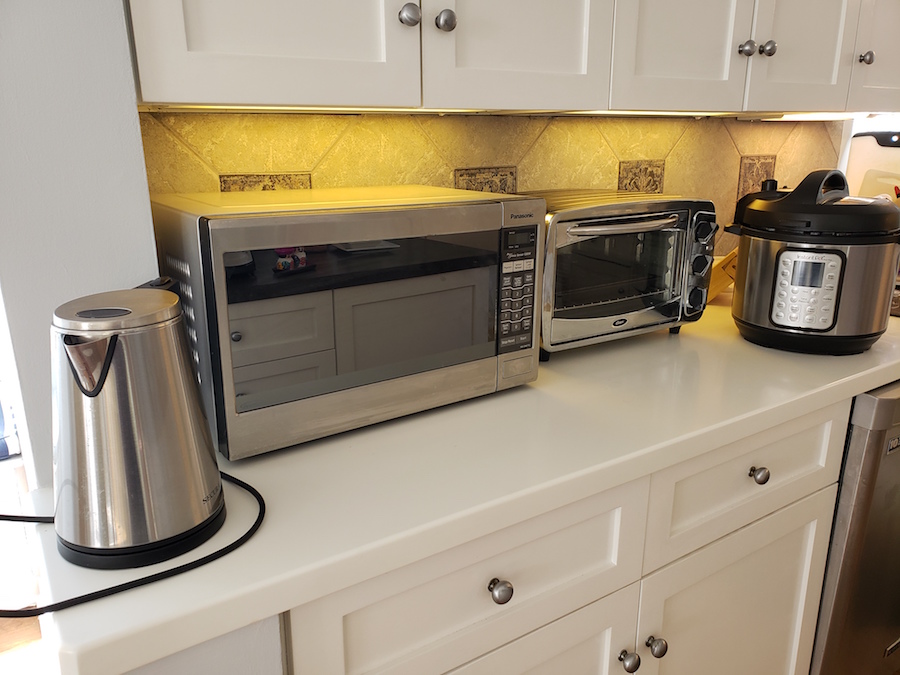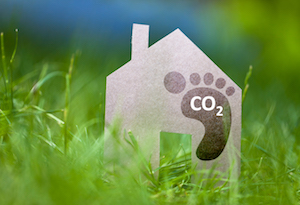Gas stoves pollute indoor air and cause climate change. Here’s what you can do to protect your health and reduce your stove’s impact.
Research shows that emissions from gas stoves — among the most common appliances in our kitchens — can threaten the air you breathe in your home and make climate change worse.
Here’s what you can do to reduce emissions from a gas stove if you have one, and what you need to know the next time you’re in the market for a new stove.
First of all, let me say that I’ve got a gas stove (that’s my burner, pictured above) and, until relatively recently, cooked pretty much everything either on the range or in the oven. But in the last couple of years, I learned four important things about natural gas that made me rethink my stove.
The first is about how natural gas is produced. It mostly comes from fracking, a polluting process that poisons our air and water and is particularly dangerous to kids. As Moms Clean Air Force has reported extensively, fracking chemicals can harm children’s brains, put pregnant moms and babies at risk, and expose children to cancer-causing toxins. If I could use the stove less, I wanted to.
The second is that despite its dubious reputation as a “clean” fuel, natural gas contributes significantly to climate change. In fact, gas-powered appliances generally “produce a really significant amount of both greenhouse gas pollution and other kinds of air pollution,” Rocky Mountain Institute’s (RMI) Denise Grab told Fast Company.
Methane, the primary component of natural gas, is a particularly potent greenhouse gas because it traps far more heat than does carbon dioxide.
Plus, natural gas is much more polluting than clean fuels like solar and wind.
“Natural gas production and usage in producing power, making fertilizer, heating our homes and cooking our food now send more carbon dioxide into the atmosphere than coal,” reports Environmental Health News
Third, I learned that gas stoves can emit excessive nitrogen dioxide (NO2), at levels often exceeding both indoor guidelines and outdoor standards.
The health effects of NO2 in children, says the nonprofit RMI, may include IQ and learning deficits, increased susceptibility to lung infections, increased risk of childhood asthma, coughing, heart stress, and increased susceptibility to allergens.
And fourth is that no federal agencies monitor the pollutants that gas stoves emit. Am I breathing in too many? There’s no way to know.
How to Reduce Pollutants From Your Gas Stove – Use These Electric Ones Instead
I’ve learned enough to decide that, when it’s time for me to replace my stove, I will choose an all-electric or an induction model. Until then, here’s what I do that might help you, too:
- Exhaust Fan—I always turn on the exhaust fan above my range. The fan is vented to the outdoors so it sucks pollutants up and away.
- Open Windows—Weather permitting, I’ll open a few windows when I’m cooking to increase fresh air into my kitchen that moves tainted air out.
- Electric Slow Cooker—I’ve switched to using an electric slow cooker (like a Crock Pot or an InstaPot or a rice cooker) for making soups, stews, sauces, rice, pasta, yogurt, and more. Some people even bake and fry in their slow cookers. In addition to improving my indoor air quality, I have found slow cookers make much less mess than cooking on my stovetop does.
- Electric Toaster Oven—In addition to a slow cooker, I have a toaster oven that is big enough for casseroles, a 10-inch pie, a rimmed tray on which I can roast chicken, fish and vegetables, and a cookie sheet big enough to make 12 cookies at a time.
- Electric Kettle—I make tea and coffee several times a day, so switching to an electric kettle was a no-brainer.
When I do decide to replace my stove, I’m going to research both electric and induction options.
I’m going to take my cues from Energy Star, EPA’s program that sets energy efficiency standards for a wide variety of common appliances. Though Energy Star has no ratings for residential ovens or ranges, the program has decided that gas water heaters, furnaces, and dryers will no longer be eligible to be listed on their “Most Efficient” list. That implies to me that gas stoves wouldn’t be either.
Don’t Miss: 7 Ways to Reduce Your Home’s Greenhouse Gas Emissions!
NOTE: This post contains affiliate links to Amazon. We will earn a minuscule commission that helps us keep Big Green Purse going if you make a purchase using our link. Thanks.
What other ideas do you have for switching to clean electricity from gas? Please join our Facebook community and let us know!



















